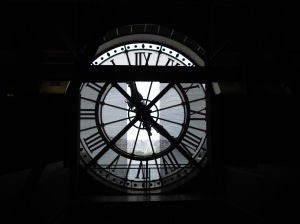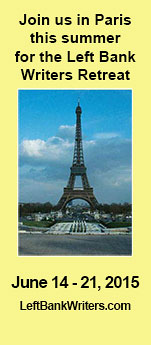I have looked forward to visiting the Orsay and the Orangerie with their important Impressionist collections. The Orsay Museum picks up where the Louvre collection leaves off—1848 to 1914– with the best general collection of Impressionist work: Manet, Monet, Renoir, Degas, Van Gogh, Cezanne, and Gauguin.
Located in a former train station, the physical building is spectacular. E-husband (and b.f.) and I enter the train station into a light- filled grand room where trains used to run. There is a crowd (we waited in line for fifteen minutes) but it isn’t uncomfortable like the crowd in the Louvre.

Grand Entry at the Orsay
Impressionism emerged because the camera threatened to make artists obsolete. The camera allowed a scene to be captured in minutes—where it might take an artist months or even years to paint. In defiance a group of artists took to the outdoors with a motto: out of the studio, into the open air. Rejecting camera-like detail, they painted their impressions or feelings of a scene in a quick style that captured the moment. Rejected by the Salon, Impressionists launched their own show in 1874—and thank goodness they are now at the Orsay so that we do not need to go back to the Louvre.

Clock at the Orsay
We quickly make our way through the main floor sculptures that are lovely but we don’t want an appetizer (or “entree” as appetizers are called in France), we head directly for the main course (or “plat principal” as they are called here). We head for the Impressionist works which are magnificent. The room of Van Gogh’s work was powerful with canvases of stars, sunflowers, gypsy camps and rivers. E-husband loved Van Gogh’s “Self Portrait. My favorite was “Starry Night Over The Rhone. There must be a color called Van Gogh blue, because it can’t be found on earth. The painting with the golden stars, blue night sky, and lights on the river is hypnotizing and just thinking about it I feel myself relax.

Vincent Van Gogh Starry Night Over The Rhone
The Orangerie is another visual spectacle. Located just 15 minutes from the Orsay, a lovely walk through the Tuileries Garden, we come to an unassuming building. “This can’t be the Orangerie,†says e-husband and I nod in agreement. We walk to the front of the building and find a guard at the door–probably going to tell us the museum is closed, we think. No, he waves us inside, we walk up to the counter, purchase a ticket and enter.
Although the outside of the building is not ostentatious, the inside is perfectly designed after a recent remodel to house two rooms of Monet’s Water Lillies. Within minutes we were sitting in the oval shaped rooms surrounded by Monet’s Water Lillies—I have seen paintings in museums of the water lilies but didn’t know they existed as wall-sized panels. He created them this way, inviting us to stroll along the curved walls as though we are strolling along his lake. The feeling is amazingly similar.

Claude Monet
Downstairs, we find the private collection of trend-setting collector Paul Gauillome who was Picasso’s art dealer—making a bridge from Impressionist to Modern works. We walk back to the apartment via the Tuileries Gardens as though we were still walking in Monet’s garden.


